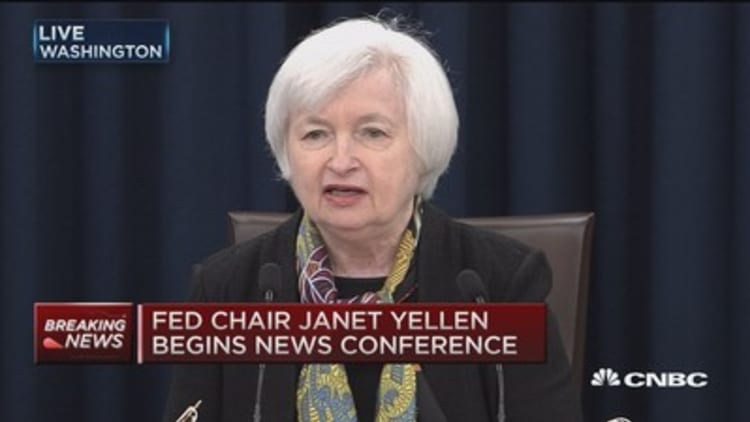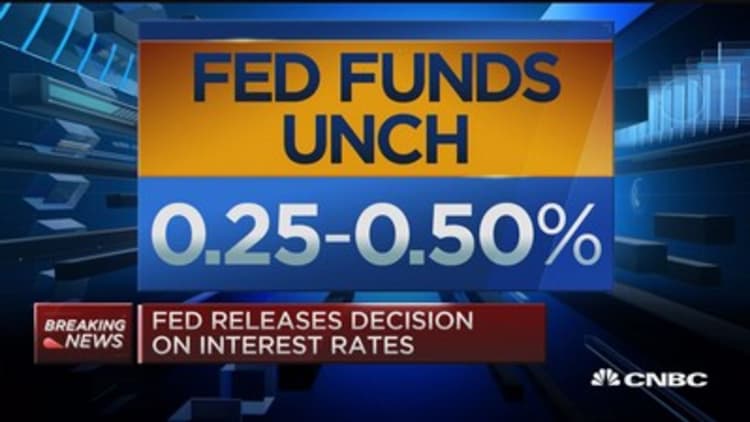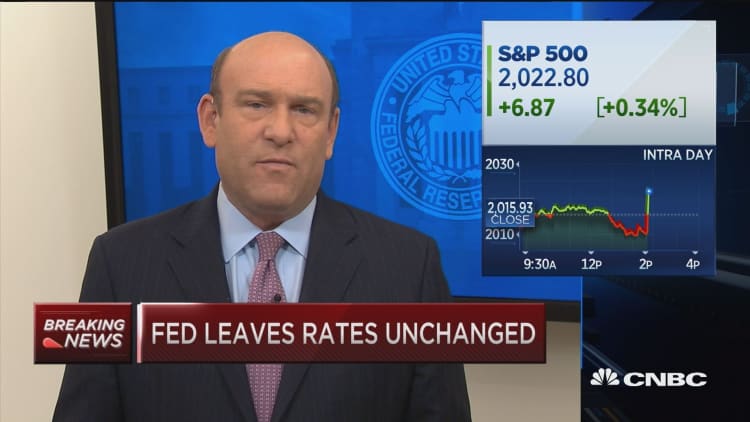


A dovish Federal Reserve held the line on interest rates Wednesday and substantially scaled back its expectations for further moves ahead.
Where the U.S. central bank at its December meeting had projected four rate hikes in 2016, new estimates released Wednesday reduced that number to two. Fed officials also cut their expectations for economic growth and inflation.
In addition to the two rate increases this year, the Federal Open Market Committee now projects just two hikes in 2017, according to the latest Summary of Economic Projections.
The current interest rate target is 0.25 to 0.5 percent, and Fed officials back in December had expected the upper level to rise to 1.4 percent by year's end. With the new projections, the FOMC now sees just a 0.9 percent funds rate in 2016 and a 1.9 percent level by the end of 2017, both reflecting cuts of half a percentage point.
The projections were included on the so-called dot plot, a graph that shows where individual members see the Fed's interest rate target each year. There was a considerable shift lower in the latest estimates.
The Fed also cut its GDP growth outlook for 2016 from 2.4 percent to 2.2 percent and reduced 2017's call from 2.2 percent to 2.1 percent.
Despite recent public comments from some members indicating that a rate hike was appropriate, the FOMC approved the decision 9-1. Only the Kansas City Fed's Esther George dissented; she wanted to hike rates at this meeting.
In the statement, the committee referenced "global and financial developments (that) continue to pose risks," language that contrasted to the December statement, which said the committee was only "closely monitoring" those conditions.
The committee saw household spending "increasing at a moderate rate," while housing "has improved further." The statement did not address the "balance of risks" issue included following some previous meetings.
Despite the Fed's aggressive rate projections at the December meeting, futures traders had been holding to a slower trajectory for the path of rate hikes. Consequently, the fed funds market moved little after the decision, except for a drop in expectations for a June rate hike.
"They still see a pretty slow-growth low-inflation world ahead of us. They're catching up with the market," said Kathy Jones, chief fixed income strategist at Charles Schwab. "The big takeaway is the Fed is adjusting to the global economy, as the market already has. It's really tough for our rates to go up much when they're negative in the rest of the world."
The committee continued to include language that it was confident inflation would gravitate toward the 2 percent goal and is lower now due largely to energy price declines. But economic projections indicated some misgivings about the current pace of growth.
Inflation expectation changes were split: Committee members see headline inflation, which includes volatile food and energy costs, at 1.2 percent by the end of the year, slightly lower than the current level and down from the December estimate of 1.6 percent.
The core personal consumption expenditures level is still expected to be 1.6 percent at the end of the year, consistent with the December projection. Core inflation projections for 2017 also were taken down a notch, from 1.9 percent to 1.8 percent.
At least in terms of economic projections the dovishness exceeded expectations from Wall Street, where some Fed watchers fully expected the committee not to raise rates but were looking for more hawkish language on rates, considering a recent upturn in economic data. Jobs and housing numbers continue to improve, while gross domestic product is likely to come in above 2 percent, after a 1 percent gain in the fourth quarter.
After more than seven years of zero interest rates and more than nine years since the last rate hike, the FOMC in December enacted a quarter-point hike. Financial conditions quickly tightened afterward, giving policymakers pause about future moves. However, the last month or so has seen a rebound, with a strong rally in stocks and a bounce in government bond yields.
Correction: This story has been updated to reflect the correct voting split among Fed members.







